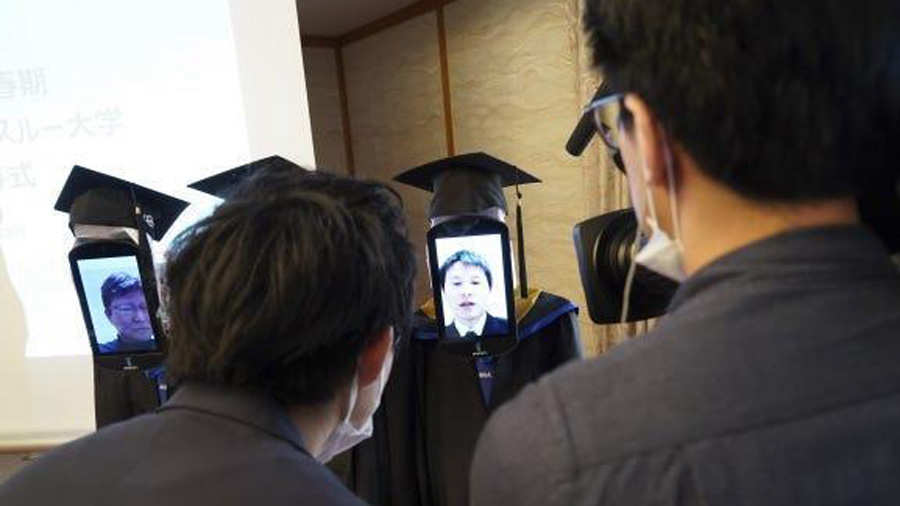Asia/Japón/euronews
Una universidad en Japón ha decidido cancelar su ceremonia de graduación debido a las medidas de distanciamiento social generadas por la pandemia de coronavirus. En cambio, un equipo de robots, con iPads para caras, está reemplazando a los estudiantes y recolectando diplomas en su nombre, escribe Maeve Campbell para Euronews .
Con el nombre de ‘Newme’, los robots han sido desarrollados por ANA Holdings como una solución basada en tecnología, para que los estudiantes no tengan que viajar hacia y desde la Universidad Business Breakthrough (BBT) en la ciudad capital de Tokio. Los ‘robots avatar’ son muy realistas, aparecen en trajes de graduación y se visten a sí mismos mientras los estudiantes controlan sus movimientos de forma remota desde su casa usando computadoras.
«Sabíamos que había muchos estudiantes que desearían asistir a la ceremonia de graduación pero no podrían hacerlo debido a la preocupación por el coronavirus», dijo a Euronews Living el profesor Shugo Yanaka, decano del departamento de gestión global de la Universidad BBT. «De repente se me ocurrió una idea de la Ceremonia de Graduación de Avatar», dice, y agrega que quería que fuera como una «experiencia de teletransportación».
El profesor Yanaka planteó la idea por primera vez en una reunión de profesores celebrada en febrero y logró dar vida al proyecto en solo un mes y medio. Esto debería ser un «mensaje positivo» para el mundo, concluye Yanaka, diciendo que espera que «energice a las personas que deseen encontrar un avance para organizar ceremonias / eventos» en este difícil período.
Se ha hecho un video documentando el día:
Soluciones tecnológicas sostenibles para combatir los viajes.
La ‘Ceremonia de graduación de Avatar’ podría ser una forma innovadora de evitar que los estudiantes viajen en medio de la crisis del coronavirus, pero no es la única solución tecnológica en respuesta a eventos y reuniones cancelados.
Los artistas pop han recurrido a Instagram para transmitir conciertos en vivo desde sus salas de estar , ya que salir y salir a conciertos ya no es posible. Los teatros transmiten en vivo obras de teatro y óperas directamente a nuestros hogares y las escuelas funcionan a través de portales de aprendizaje electrónico . Los empleados funcionan a través de reuniones en aplicaciones de video como Zoom e incluso las bodas socialmente distanciadas se están moviendo en línea.
Los activistas climáticos han estado pidiendo que se realicen más reuniones a través de videollamadas durante algún tiempo, a medida que la crisis ambiental continúa aumentando. El sector de viajes representa el 8 por ciento de las emisiones globales de carbono en general y viajar por trabajo cubre una gran parte de eso. En 2018, la empresa multinacional de contabilidad PwC estimó que los viajes de negocios fueron el mayor contribuyente a su huella de carbono como empresa, representando el 53 por ciento.
Como resultado, la demanda de reuniones virtuales ya se está disparando. “A nadie le gusta levantarse a las 4 de la mañana para llegar a un aeropuerto y pasar un par de días en reuniones sin ver un lugar. No es viajar, es solo moverse a donde trabajas «, dijo a Wired Fred Mazzella, fundador del servicio de coche compartido BlaBlaCar.
«Es bueno para el medio ambiente y para el equilibrio entre la vida laboral y personal»
Fuente: https://www.euronews.com/living/2020/04/07/robots-attend-graduation-in-place-of-students-at-japanese-university














 Users Today : 150
Users Today : 150 Total Users : 35459745
Total Users : 35459745 Views Today : 271
Views Today : 271 Total views : 3418243
Total views : 3418243